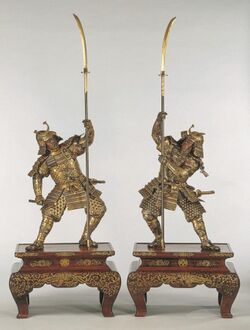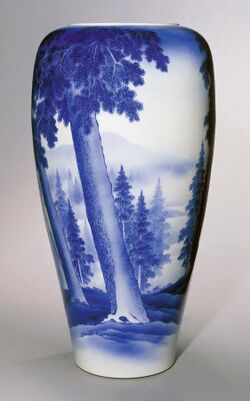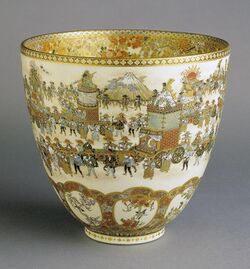Khalili Collection of Japanese Art
Topic: Engineering
 From HandWiki - Reading time: 11 min
From HandWiki - Reading time: 11 min
| The Khalili Collection of Japanese Art | |
|---|---|
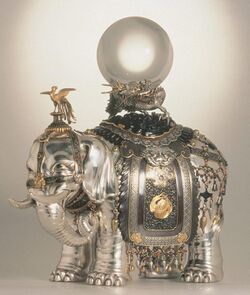 Incense burner (Koro), silver decorated with precious metals and rock crystal, 1890 | |
| Curators | Nasser D. Khalili (founder) Dror Elkvity (curator and chief co-ordinator) Gregory Irvine (honorary curator)[1] |
| Size (no. of items) | 1,400[2] |
| Website | https://www.khalilicollections.org/all-collections/japanese-art-of-the-meiji-period/ |
The Khalili Collection of Japanese Art is a private collection of decorative art from Meiji-era (1868–1912) Japan , assembled by the British-Iranian scholar, collector and philanthropist Nasser D. Khalili.[3] With more than 1,400 objects in total,[2] it is comparable only to the collection of the Japanese imperial family in terms of size and quality.[4] The collection includes metalwork, enamels, ceramics, and lacquered objects, including works by artists of the imperial court that were exhibited at the Great Exhibitions of the late 19th century.[5] Rather than covering the whole range of Meiji-era decorative art, Khalili has focused on objects of the highest technical and artistic quality.[6] He observed that Japanese arts were less well-documented than European arts of the same period, despite being technically superior: "Whilst one could argue it is relatively easy to replicate a Fabergé, to replicate the work of the Japanese master is nigh on impossible."[7] The collection is one of eight assembled, published, and exhibited by Khalili, and one of three that feature art works from Japan, along with the Khalili Collection of Kimono and the Khalili Collection of Enamels of the World.[8][9]
Although the collection is not on permanent public display, its objects are lent to cultural institutions and have appeared in many exhibitions from 1994 onwards. Exhibitions drawing exclusively from the collection have been held at the British Museum, Israel Museum, Van Gogh Museum, Portland Museum, Moscow Kremlin Museums, and other institutions worldwide.[2][7] As well as assembling these collections, Khalili founded the Kibo Foundation (from the Japanese word for "hope") to promote the study of art and design of the Meiji era, publishing scholarship about the collection and its historical context.[7]
Background: the Meiji Era
The Meiji era was a period of modernisation and industrialisation, during which Japan opened itself to the world.[10] It saw a rapid introduction of Western culture to Japan, and also of Japanese culture into Europe and America.[11] The Khalili Collection has been used in research to study how Japanese art was widely available in Europe during the late 19th and early 20th century, and influenced European art, especially Vincent van Gogh and the impressionists.[12]
During the embrace of Western influences, demand for Japanese art declined within Japan itself. At the same time, art objects came to be a large part of Japan's exports, actively promoted by the government which wanted to reduce the country's trade deficit with the West.[12] The government took an active interest in the standard of art exported, exerting quality control via the Hakurankai Jimukyoku (Exhibition Bureau).[13] The major exhibitions to which Japan sent the best examples of its arts and crafts included the Vienna World Exhibition of 1873,[14] the Centennial International Exhibition of 1876 in Philadelphia, the World's Columbian Exposition in Chicago in 1893 and the Louisiana Purchase Exposition of 1901 in St. Louis.[5]
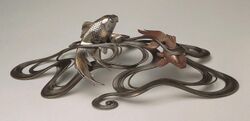
Objects
Twenty-five of the objects have emblems showing that they were commissioned by the Emperor as gifts for foreign dignitaries and royalty.[15] Another twelve were made especially for the great international exhibitions around the turn of the 20th century.[15]
Metalwork
Khalili's collection and documentation of Meiji era metalwork is a major factor in the resurgence of interest in the topic in recent decades.[16] The 1995 catalogue lists 161 items of metalwork, exemplifying a variety of techniques and with themes from the history and legends of both Japan and China.[17] Meiji era artists created ambitious works in cast bronze for display at world's fairs, impressing American reviewers.[18] One of the metalworkers who exhibited at these fairs, eventually appointed an Artist to the Imperial Household, was Suzuki Chokichi, whose art name was Kako.[19] Several of his works, including two intricately decorated incense burners, are in the collection.[20]
The past history of samurai weaponry equipped Japanese metalworkers to create metallic finishes in a wide range of colours. By combining and finishing copper, silver and gold in different proportions they could give the impression of full-colour decoration.[21] Some of these metalworkers were appointed Artists to the Imperial Household, including Kano Natsuo, Unno Shomin, Namekawa Sadakatsu, and Jomi Eisuke II, each of whom is represented in the collection.[22] Other highlights include an elephant incense burner by Shoami Katsuyoshi, a sculpture of the deity Susanoo-no-Mikoto by Otake Norikuni, and a group of iron pieces by the Komai family of Kyoto, decorated with gold with a process known in the West as damascening.[23][24]
Enamels
During the Meiji era, Japanese cloisonné enamel reached a technical peak, producing items more advanced than any that had existed before.[25] Artists experimented with pastes and with the firing process to produce ever larger blocks of enamel, with less need for cloisons (enclosing metal strips).[25] Many enamel objects were exhibited in the Fine Art section of the National Industrial Exposition of 1895,[26] The best examples from this period, including some in the Khalili Collection, could not be replicated today.[25] Designs went from copies of Chinese objects to a distinctively Japanese style.[27] The collection's near-300 cloisonné enamel objects include many works by each of three notable artists: Namikawa Yasuyuki, Namikawa Sōsuke, and Ando Jubei.[28] These are regarded as the three great innovators of the golden age of Japanese cloisonné: they developed new firing techniques and reduced the visibility of wires.[29] Namikawa Yasuyuki and Namikawa Sōsuke are known for introducing pictorial styles of cloisonné.[26] This is exemplified in the collection by an incense burner by Namikawa Yasuyuki, created for presentation to the Emperor, that combines enamel with gold and shakudō to depict a landscape scene.[30] Researchers have used the collection to establish a chronology of the development of Japanese enamelling.[28][27]
Among the cloisonné enamel works is a trio of vases that have become known as the Khalili Imperial Garniture. Exhibited at the World's Columbian Exposition in Chicago , United States, in 1893, they were described as "the largest examples of cloisonné enamel ever made".[31][32] From the early 1990s to 2019, Khalili acquired the three pieces, including the third which had been considered 'lost' to the art trade.[32][33] The design of the vases includes the symbolic use of a dragon, chickens, and eagles, on scenes representing the four seasons of the year.[31]
Lacquer
Some of the pieces in the lacquer collection go back to the 17th century.[34] A lacquer artist strongly represented is Shibata Zeshin,[35] who has been called "Japan's greatest lacquerer".[36] His works have an idiosyncratic, highly decorative style and the hundred works in the Khalili Collection of Japanese Art merited a dedicated volume in the 1995 set of catalogues.[35] A highlight of the lacquer collection is a cabinet by Harui Komin, commissioned by the Japanese Crown Prince for presentation to the future King Edward VIII of the United Kingdom.[34] Other highlights include works by Nakayama Komin and Shirayama Shosai,[34] who along with Shibata Zeshin are considered the three great late lacquerers of Japan.[37] There are many examples of shibayama technique,[34] in which designs are carved into natural materials which are inlaid in the lacquer.[38]
Porcelain
The collection includes, among other porcelain works, more than eighty by Miyagawa (Makuzu) Kozan, described in 1910 as Japan's greatest living ceramic artist.[39][40] Kozan was the second ceramicist ever to be appointed Artist to the Imperial Household.[40] He and his workshop transformed underglaze blue porcelain, decorating with subtleties of colour that had not previously been possible.[41] He also made award-winning objects with flambé or crystalline glaze.[42] Some of his works showed an influence of European graphic design, while he combined traditional Japanese and Chinese techniques with new technologies from the West.[43] As he and his son Hanzan prepared works for international exhibition, they became increasingly ambitious, introducing new colours, designs and sculptural effects which are exemplified in the collection.[41]
Earthenware
The 171 earthenware objects in the collection include some by Yabu Meizan and his contemporaries, typically decorated with enamel and gold.[44] Meizan was not only a prolific producer but won multiple awards at national and international exhibitions, where his creations were exhibited as works of art.[45] The collection shows that Meizan used Chinese as well as Japanese motifs in his decoration, drawing from sources including Buddhist imagery and the prints of Hiroshige.[46] His designs became more intricate, sometimes using a thousand motifs in a single art work, while towards the end of his career he took a different approach, covering whole vases in a single motif.[47] Kinkozan Sobei VII and Takbe Shoko are other distinctive decorators represented in the collection.[48]
Textiles
The collection also includes over 200 examples of silk textile work from the latter half of the Meiji era,[49] mostly produced by workshops in Kyoto.[50] One of these was presented to Nicholas II of Russia by the Emperor during the former's visit to Japan in 1891.[50] Other items were exhibited at Japan's fifth National Industrial Exposition of 1903.[51] These included works by Nishimura Sozaemon, an embroidery firm appointed by the Imperial household.[52]
Publications
In 1995, the collection was documented in a multi-volume catalogue by Oliver Impey, reader in Japanese Art at the University of Oxford, and Malcolm Fairley, co-owner of the Asian Art Gallery in London. A separate volume of essays uses the collection to explore the phenomenon of Japonisme: the enthusiasm for Japanese arts in late 19th century Europe.[12] There are also catalogues from various exhibitions.
- Harris, Victor (1994). Japanese imperial craftsmen : Meiji art from the Khalili collection. London: British Museum Press. ISBN 0714114634.
- Impey, Oliver; Fairley, Malcolm (1994). Treasures of Imperial Japan: Ceramics from the Khalili Collection. Kibo Foundation. ISBN 978-1-874780-12-0.
- Impey, Oliver; Fairley, Malcolm (1995). Volume I – Meiji No Takara – Treasures of Imperial Japan; Selected Essays. Kibo Foundation. ISBN 9781874780014.
- Impey, Oliver; Fairley, Malcolm (1995). Volume II – Meiji No Takara – Treasures of Imperial Japan; Metalwork Parts One & Two. Kibo Foundation. ISBN 9781874780021.
- Impey, Oliver; Fairley, Malcolm (1995). Volume III – Meiji No Takara – Treasures of Imperial Japan; Enamel. Kibo Foundation. ISBN 9781874780038.
- Impey, Oliver; Fairley, Malcolm; Earle, Joe (1995). Volume IV – Meiji No Takara – Treasures of Imperial Japan; Lacquer Parts One & Two. Kibo Foundation. ISBN 9781874780045.
- Impey, Oliver; Fairley, Malcolm (1995). Volume V, Part I – Meiji No Takara – Treasures of Imperial Japan; Ceramics Part One: Porcelain. Kibo Foundation. ISBN 9781874780052.
- Impey, Oliver; Fairley, Malcolm (1995). Volume V, Part II – Meiji No Takara – Treasures of Imperial Japan; Ceramics Part Two: Earthenware. Kibo Foundation. ISBN 9781874780069.
- Earle, Joe (1995). Volume VI – Meiji No Takara – Treasures of Imperial Japan; Masterpieces by Shibata Zeshin. Kibo Foundation. ISBN 9781874780083.
- Earle, Joe (1997). Shibata Zeshin : masterpieces of Japanese lacquer from the Khalili Collection. Edinburgh: National Museums of Scotland. ISBN 1-874780-09-9. OCLC 37794363.
- Earle, Joe (1999). Splendors of Meiji : treasures of imperial Japan : masterpieces from the Khalili Collection. St. Petersburg, Fla.: Broughton International Inc. ISBN 1874780137. OCLC 42476594.
- Earle, Joe (2002). Splendors of Imperial Japan : arts of the Meiji period from the Khalili Collection. London: Khalili Family Trust. ISBN 1-874780-19-6. OCLC 49043675.
- Schiermeier, Kris (2006). Wonders of imperial Japan : Meiji art from the Khalili collection. Zwolle: Waanders Publishers. ISBN 90-400-8234-0. OCLC 71522673.
- Schiermeier, Kris (2006). Japan : Meiji-Kunst & Japonismus : Aus der Sammlung Khalili. Krems: Kunsthalle. ISBN 3-901261-34-6. OCLC 150163591.
- Irvine, Gregory, ed (2013). Japonisme and the rise of the modern art movement : the arts of the Meiji period : the Khalili collection. New York: Thames & Hudson. ISBN 978-0-500-23913-1. OCLC 853452453.
- Amelëkhina, S. A.; Амелёхина, С. А. (2017). Za granʹi︠u︡ voobrazhenii︠a︡ : sokrovishcha imperatorskoĭ I︠A︡ponii XIX - nachala XX veka iz kollekt︠s︡ii professora Khalili. Moscow: Moscow Kremlin Museums. ISBN 978-5-88678-308-7. OCLC 1014032691.
Exhibitions and loans
The following exhibitions were drawn exclusively from the Khalili Collection of Japanese Art.[2]
- Japanese Imperial Craftsmen: Meiji Art from the Khalili Collection
- Sep 1994 – Jan 1995, British Museum, London, UK
- Treasures of Imperial Japan: Ceramics from the Khalili Collection
- Oct 1994 – Jan 1995, National Museum of Wales, Cardiff, UK
- Shibata Zeshin: Masterpieces of Japanese Lacquer from the Khalili Collection
- Apr – Oct 1997, National Museums of Scotland, Edinburgh, UK
- Splendors of Meiji: Treasures of Imperial Japan
- Apr – Oct 1999, First USA Riverfront Arts Centre, Wilmington, Delaware, USA
- Shibata Zeshin: Masterpieces of Japanese Lacquer from the Khalili Collection
- Oct – Nov 1999, Toyama Sato Art Museum, Toyama, Japan
- Nov 2000 – Mar 2001, Roemer and Pelizaeus Museum, Hildesheim, Germany
- Splendors of Imperial Japan: Arts of the Meiji Period from the Khalili Collection
- June – Sep 2002, Portland Art Museum, Portland, Oregon, USA
- Splendors of Imperial Japan: Masterpieces from the Khalili Collection
- Sep 2004 – Feb 2005, Israel Museum, Jerusalem, Israel
- Wonders of Imperial Japan: Meiji Art from the Khalili Collection
- Jul – Oct 2006, Van Gogh Museum, Amsterdam, Netherlands
- Meiji-Kunst & Japonismus: Aus der Sammlung Khalili
- Feb – Jun 2007, Kunsthalle Krems, Krems, Austria
- Beyond Imagination: Treasures of Imperial Japan from The Khalili Collection, 19th to early 20th century
- Jul – Oct 2017, Moscow Kremlin Museums, Moscow, Russia[53]
Items from the collection were lent to the following exhibitions:
- Kyoto–Tokyo: from Samurai to Manga
- Jul – Sep 2010, Grimaldi Forum, Monaco
- Meiji, splendeurs du Japon impérial (Splendours of Imperial Japan)
In June 2014, the Khalili Foundation made two donations of Japanese art to the UNESCO art collection. A pair of large (145cm high) cloisonné enamel vases were accompanied by a pair of bronze vases depicting birds in high relief.[56][57]
See also
- List of collections of Japanese art
References
- ↑ "Japanese Art of the Meiji Period (1868 – 1912)". http://www.kibofoundation.org/collections/category/2. Retrieved 27 March 2020.
- ↑ 2.0 2.1 2.2 2.3 "The Eight Collections" (in en-GB). https://www.nasserdkhalili.com/the-eight-collections-2/.
- ↑ Arkell, Roland (1 March 2019). "Renowned collector Nasser Khalili revealed as buyer of 'lost' monumental Meiji vase as he reunites it with original set". Antiques Trade Gazette. https://www.antiquestradegazette.com/news/2019/renowned-collector-nasser-khalili-revealed-as-buyer-of-lost-monumental-meiji-vase-as-he-reunites-it-with-original-set/.
- ↑ Gagarina, Elena (2017). "Foreword". in Amelekhina, Svetlana. Beyond Imagination: Treasures of Imperial Japan from the Khalili collection, 19th to early 20th centuries. Moscow. pp. 7. ISBN 978-5-88678-308-7. OCLC 1014032691. "Comparable, as acknowledged by many scholars and museum directors, in terms of quality and size only to the collection of the Japanese imperial family, this celebrated collection comprises outstanding art works created during the "Great Change" when, after more than two hundred years of isolation, Japan began promoting itself internationally as a country of rich cultural traditions."
- ↑ 5.0 5.1 Earle 1999, p. 10.
- ↑ Wylie, Hugh (Autumn 1998). "Review: The Nasser D. Khalili Collection: Decorative Arts of Meiji Japan". Monumenta Nipponica 53 (3): 411. doi:10.2307/2385732.
- ↑ 7.0 7.1 7.2 Khalili, Nasser D.. "Editorial / In a way all my work is founded on Japanese art". Guimet Museum. https://www.guimet.fr/editorial/in-a-way-all-my-work-is-founded-on-japanese-art/.
- ↑ "The Khalili Collections | Enamels Of The World" (in en-US). https://www.khalilicollections.org/all-collections/enamels-of-the-world/.
- ↑ "The Khalili Family Trust | Collections Online | British Museum". https://www.britishmuseum.org/collection/term/BIOG247264.
- ↑ Guth 2015, pp. 106–107.
- ↑ Iwao 2015, p. 9.
- ↑ 12.0 12.1 12.2 Cortazzi, Sir Hugh (2014-01-16). "[Review: Japonisme and the Rise of the Modern Art Movement: The Arts of the Meiji Period, The Khalili Collection"] (in en-US). https://www.japansociety.org.uk/32963/japonisme-cortazzi/.
- ↑ Liddell, C. B. (2013-12-14). "[Review: Japonisme and the Rise of the Modern Art Movement: The Arts of the Meiji Period"] (in en-US). https://www.japantimes.co.jp/culture/2013/12/14/books/book-reviews/japonisme-and-the-rise-of-the-modern-art-movement-the-arts-of-the-meiji-period/.
- ↑ Earle 1999, pp. 42–44.
- ↑ 15.0 15.1 "Japanese Art of the Meiji Period" (in en-US). https://www.khalilicollections.org/all-collections/japanese-art-of-the-meiji-period/.
- ↑ Seton, Alistair (2012). Collecting Japanese Antiques. New York: Tuttle Publishing. pp. 235. ISBN 978-1-4629-0588-1. OCLC 798535552. "During the last few decades, however, interest has again surged in Meiji era metalwork, perhaps due in large measure to the great collections amassed, published, and exhibited by Dr Nasser Khalili of the Kibo Foundation, London, but also to strong New York attraction for articulated dragons [...], for example, and multi-art pieces."
- ↑ "Meiji No Takara - Treasures of Imperial Japan; Metalwork Parts One & Two" (in en-US). https://www.khalilicollections.org/portfolio/meiji-no-takara-treasures-of-imperial-japan-metalwork-part-one/.
- ↑ Earle 1999, p. 64.
- ↑ Earle 1999, pp. 36, 65.
- ↑ Earle 1999, pp. 37-43.
- ↑ Earle 1999, p. 66.
- ↑ Earle 1999, pp. 66, 70, 237, 370, 372.
- ↑ "Meiji No Takara - Treasures of Imperial Japan; Metalwork Part Two" (in en-US). https://www.khalilicollections.org/portfolio/meiji-no-takara-treasures-of-imperial-japan-metalwork-part-two/.
- ↑ Earle 1999, p. 67.
- ↑ 25.0 25.1 25.2 Earle 1999, p. 252.
- ↑ 26.0 26.1 Earle 1999, p. 255.
- ↑ 27.0 27.1 Earle 1999, p. 254.
- ↑ 28.0 28.1 "Meiji No Takara – Treasures of Imperial Japan: Enamel". https://www.khalilicollections.org/portfolio/meiji-no-takara-treasures-of-imperial-japan-enamel/.
- ↑ Leonard, Loryn (2012-06-26). "How It’s Made: Japanese Cloisonné" (in en-US). https://blog.dma.org/2012/06/26/how-its-made-japanese-cloisonne/.
- ↑ Earle 1999, pp. 255, 364.
- ↑ 31.0 31.1 Earle, Joe. (1999). Splendors of Meiji : treasures of imperial Japan : masterpieces from the Khalili Collection. St. Petersburg, Fla.: Broughton International Inc. pp. 234. ISBN 1-874780-13-7. OCLC 42476594.
- ↑ 32.0 32.1 Arkell, Roland (1 March 2019). "Renowned collector Nasser Khalili revealed as buyer of 'lost' monumental Meiji vase as he reunites it with original set". https://www.antiquestradegazette.com/news/2019/renowned-collector-nasser-khalili-revealed-as-buyer-of-lost-monumental-meiji-vase-as-he-reunites-it-with-original-set/.
- ↑ "News | The Khalili Collections Reunites Landmark Imperial Japanese Garniture – Said to be The Largest Examples of Cloisonné Enamel Ever Made – After Over 120 Years" (in en-US). 2019-04-12. https://www.khalilicollections.org/islamic-art/the-khalili-collections-reunites-landmark-imperial-japanese-garniture-said-to-be-the-largest-examples-of-cloisonne-enamel-ever-made-after-over-120-years/.
- ↑ 34.0 34.1 34.2 34.3 "Meiji No Takara - Treasures of Imperial Japan; Lacquer Part One" (in en-US). https://www.khalilicollections.org/portfolio/meiji-no-takara-treasures-of-imperial-japan-lacquer-part-one/.
- ↑ 35.0 35.1 "Meiji No Takara - Treasures of Imperial Japan; Masterpieces by Shibata Zeshin" (in en-US). https://www.khalilicollections.org/portfolio/meiji-no-takara-treasures-of-imperial-japan-masterpieces-by-shibata-zeshin/.
- ↑ Earle, Joe (March 2008). "Zeshin Redux". Orientations 29 (2): 136. ISSN 0030-5448.
- ↑ "Writing box (suzuribako), 1860s". Minneapolis Institute of Art. https://collections.artsmia.org/art/99242/writing-box-nakayama-komin. Retrieved 27 March 2020.
- ↑ Miller, Judith (2017) (in en). Miller's Antiques Handbook & Price Guide 2018-2019. Octopus. pp. 113. ISBN 978-1-78472-267-8. https://books.google.com/?id=l1U_DQAAQBAJ&pg=PA113.
- ↑ "Meiji No Takara - Treasures of Imperial Japan; Ceramics Part One: Porcelain" (in en-US). https://www.khalilicollections.org/portfolio/meiji-no-takara-treasures-of-imperial-japan-ceramics-part-one-porcelain/.
- ↑ 40.0 40.1 Earle 1999, p. 333.
- ↑ 41.0 41.1 Earle 1999, p. 332.
- ↑ Earle 1999, p. 331.
- ↑ Earle 1999, pp. 331-2.
- ↑ "Meiji No Takara - Treasures of Imperial Japan; Ceramics Part Two: Earthenware" (in en-US). https://www.khalilicollections.org/portfolio/meiji-no-takara-treasures-of-imperial-japan-ceramics-part-two-earthenware/.
- ↑ Earle 1999, pp. 117–118.
- ↑ Earle 1999, p. 118.
- ↑ Earle 1999, pp. 118–119.
- ↑ Earle 1999, pp. 119, 132.
- ↑ "Embroidered Wonders Meiji era textiles in the Khalili Collections..." (in en-US). https://www.khalilicollections.org/portfolio/embroidered-wonders-meiji-era-textiles-in-the-khalili-collections/.
- ↑ 50.0 50.1 Earle 1999, p. 322.
- ↑ Earle 1999, pp. 323, 326.
- ↑ Earle 1999, p. 323.
- ↑ Muchnik, Andrei (2017-09-14). "The Moscow Fall Art Season Sizzles" (in en). https://www.themoscowtimes.com/2017/09/14/the-moscow-fall-art-season-sizzles-a58947.
- ↑ "Splendours of Imperial Japan, Guimet Museum, Paris" (in en-US). 2018-10-17. https://www.khalilicollections.org/japanese-art-of-the-meiji-period/splendours-of-imperial-japan-guimet-museum-paris/.
- ↑ "Meiji, Splendeurs du Japon impérial (1868-1912)". Guimet Museum. https://www.guimet.fr/event/meiji-1868-1912/.
- ↑ "Pair of bronze vases, Meiji period (Japan, 1868-1912)". UNESCO. http://www.unesco.org/artcollection/DetailAction.do?idOeuvre=3157&critere=PAYS_ORIGINE&index=all. Retrieved 26 March 2020.
- ↑ "Pair of vases, Meiji period (Japan, 1868-1912)". UNESCO. http://www.unesco.org/artcollection/DetailAction.do?idOeuvre=3158&critere=PAYS_ORIGINE&index=all. Retrieved 26 March 2020.
Sources
- Earle, Joe (1999). Splendors of Meiji : treasures of imperial Japan : masterpieces from the Khalili Collection. St. Petersburg, Fla.: Broughton International Inc. ISBN 1874780137. OCLC 42476594.
- Guth, Christine M. E. (2015). "The Meiji era: the ambiguities of modernization". in Jackson, Anna. Kimono: the art and evolution of Japanese fashion. London: Thames & Hudson. pp. 106–111. ISBN 9780500518021. OCLC 990574229.
- Iwao, Nagasaki (2015). "Clad in the aesthetics of tradition: from kosode to kimono". in Jackson, Anna. Kimono: the art and evolution of Japanese fashion. London: Thames & Hudson. pp. 8–11. ISBN 9780500518021. OCLC 990574229.
External links
 KSF
KSF